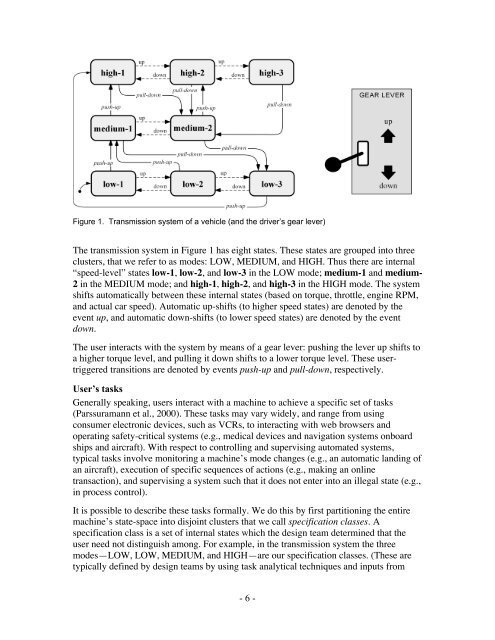formal analysis and automatic generation of user interfaces
formal analysis and automatic generation of user interfaces
formal analysis and automatic generation of user interfaces
You also want an ePaper? Increase the reach of your titles
YUMPU automatically turns print PDFs into web optimized ePapers that Google loves.
Figure 1. Transmission system <strong>of</strong> a vehicle (<strong>and</strong> the driver’s gear lever)<br />
The transmission system in Figure 1 has eight states. These states are grouped into three<br />
clusters, that we refer to as modes: LOW, MEDIUM, <strong>and</strong> HIGH. Thus there are internal<br />
“speed-level” states low-1, low-2, <strong>and</strong> low-3 in the LOW mode; medium-1 <strong>and</strong> medium-<br />
2 in the MEDIUM mode; <strong>and</strong> high-1, high-2, <strong>and</strong> high-3 in the HIGH mode. The system<br />
shifts <strong>automatic</strong>ally between these internal states (based on torque, throttle, engine RPM,<br />
<strong>and</strong> actual car speed). Automatic up-shifts (to higher speed states) are denoted by the<br />
event up, <strong>and</strong> <strong>automatic</strong> down-shifts (to lower speed states) are denoted by the event<br />
down.<br />
The <strong>user</strong> interacts with the system by means <strong>of</strong> a gear lever: pushing the lever up shifts to<br />
a higher torque level, <strong>and</strong> pulling it down shifts to a lower torque level. These <strong>user</strong>triggered<br />
transitions are denoted by events push-up <strong>and</strong> pull-down, respectively.<br />
User’s tasks<br />
Generally speaking, <strong>user</strong>s interact with a machine to achieve a specific set <strong>of</strong> tasks<br />
(Parssuramann et al., 2000). These tasks may vary widely, <strong>and</strong> range from using<br />
consumer electronic devices, such as VCRs, to interacting with web browsers <strong>and</strong><br />
operating safety-critical systems (e.g., medical devices <strong>and</strong> navigation systems onboard<br />
ships <strong>and</strong> aircraft). With respect to controlling <strong>and</strong> supervising automated systems,<br />
typical tasks involve monitoring a machine’s mode changes (e.g., an <strong>automatic</strong> l<strong>and</strong>ing <strong>of</strong><br />
an aircraft), execution <strong>of</strong> specific sequences <strong>of</strong> actions (e.g., making an online<br />
transaction), <strong>and</strong> supervising a system such that it does not enter into an illegal state (e.g.,<br />
in process control).<br />
It is possible to describe these tasks <strong>formal</strong>ly. We do this by first partitioning the entire<br />
machine’s state-space into disjoint clusters that we call specification classes. A<br />
specification class is a set <strong>of</strong> internal states which the design team determined that the<br />
<strong>user</strong> need not distinguish among. For example, in the transmission system the three<br />
modes—LOW, LOW, MEDIUM, <strong>and</strong> HIGH—are our specification classes. (These are<br />
typically defined by design teams by using task analytical techniques <strong>and</strong> inputs from<br />
- 6 -

















